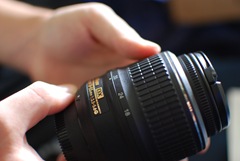The new lens arrived this morning. Amazon listed the item as “unknown delivery date” until sometime Wednesday evening, and then on Thursday before I returned home, the lens had shipped and it arrived today. This lens concludes the summer upgrades to my camera system. At this point the lens has only been used for about 18 shots, since the weather has been less than ideal for f/1.8 images today, and this evening at dusk (a good time for the lens) I was busy with a Statistics test.
In a complete irony, an Introduction to Optics textbook that I purchased recently arrived today as well. It was interesting to read how the f-number is calculated.
From the few images I have taken with the new lens I must conclude that it definitely lets a lot of light in and creates an interesting depth of field. It also seems as though the D60 has a few issues metering with the lens, since the automatically metered modes read things a little overly bright.
It is somewhat difficult for me to work with a static prime lens on the D60, since I have gotten so used to sitting still to compose and then zooming to adjust. Now I have a lens that will essentially do nothing notable except let light in, but in photography, that in itself is a wonderful thing.
Here is a sample image, it is Chris holding the 18-55mm lens, which was mounted on the D60 at the time the new lens arrived.
The image is a little overly bright and not as sharp as it could be, probably due to the fact it is too bright (too many stops too slow). My only complaint with this lens is that it is not a VR lens, but oh well, the faster lens speed is supposed to make up for that. While at first I wasn’t sure about using flash with this lens, I now think it might be an interesting thing to try, if for no other reason, just to see how low of a power the flash has to use to match what is needed.
Primarily this lens will be used for portraits, macro and landscapes. It is equivalent to around 50mm on my D-SLR.
